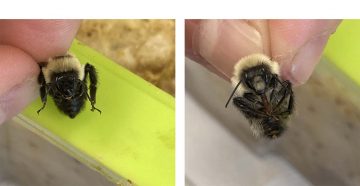 Written by: Alison McAfee (she/her), PhD (Genome Science and Technology)
Written by: Alison McAfee (she/her), PhD (Genome Science and Technology)
Post-doctoral Fellow, Applied Ecology
North Carolina State University
Michael Smith Laboratories
CBR affiliated Fellow
University of British Columbia
Research supported by the CBR Transition Grant shows that male bumble bees are more sensitive to heat than honey bees.
The drumbeat of our changing climate is getting louder every year. The 2018 wildfire season was the worst in British Columbia’s recorded history. In 2019, we had a record-setting hot spring. In 2021, BC felt some of the hottest temperatures ever registered in the country. Now, in 2022, records have been shattered again with an unusually warm fall. It seems like we’re on track to break the record for the most records broken in the last five years, and there’s no sign of abating.
And we aren’t the only ones feeling the heat. Pollinators, like honey bees and bumble bees, are feeling it too. My research on male and female honey bees shows that hot temperatures can lead to infertility, making it harder for them to reproduce and maintain robust colonies. But how different types of bees withstand hot temperatures is not well understood, and thanks to the support of a CBR Transition Grant, I am working on finding this out.

A female (left) and male (right) Bombus impatiens bumble bee. Note the hairy face of the male, like a mustache.
Until receiving this grant, I had only researched honey bees, and did not have experience handling and rearing other bee species. I wanted to study bumble bees because their populations are more vulnerable than honey bees, yet so little is known about them. Honey bees are useful models, but we also need to research other species directly, including at least some of the 45 different species of bumble bees in Canada. The CBR Transition Grant has given me the opportunity to buy and rear commercially produced bumble bees (Bombus impatiens), giving me skills which I can transfer to other bumble bee species, too.
And with our changing climate, studying bumble bee heat tolerance is a salient topic. In 2020, researchers at the University of Ottawa found that extreme temperatures are the best predictors of local bumble bee extinctions. Male honey bees are notoriously sensitive to heat – much more than their female counterparts – but sensitivity of most bumble bee species is not known. If they are sensitive, that could be driving the relationship between heat and extinction.
Last summer, I began to test how male Bombus impatiens heat tolerance stacked up to male honey bees. But I didn’t compare these bumble bees to your average honey bee: I compared them to honey bees with genetic origins from Ukraine, Australia, and California; rationale being, stocks from different climates might have different heat tolerances. In a “common garden” experiment, I reared the bumble bees and honey bees imported from different countries together at UBC and measured male survival after a heat challenge.
The results shocked me. I actually expected the bumble bee males to be made of tougher stuff than honey bee males, since bumble bee males live most of their mature lives outside the nest, subsisting on food they forage for themselves. They are exposed to whatever Mother Nature throws at them, whereas honey bee males can go back to their air-conditioned colonies. But the bumble bees were actually significantly more likely to die, with only about 65% surviving a short heat challenge (4 h at 42° C) compared to 95% of honey bees. Honey bees from different genetic origins fared similarly, and I am currently working on seeing if their fertility suffered or stayed the same.

A male Bombus impatiens caught in the garden.
This finding does not bode well for the bumble bees, but male survival and fertility is only half of the equation. Similar to honey bees, queen bumble bees mate and store sperm within a specialized organ, the spermatheca, for their lifetime (one year). The biological processes enabling this long-term storage, and how extreme temperatures influence them, though, is largely a mystery for bumble bees and other social insects.
Through a collaboration with researchers at the University of Brussels, Belgium, I am now working to determine the similarities and differences between honey bee, bumble bee, and ant sperm storage using comparative proteomics. Once complete, this research will tell us how generalizable the data for honey bees are, and whether they are a useful indicator for how environmental stress might impact queens of other species.
I am deeply thankful for the support of the CBR Transition Grant, which has made this research possible. The funds have given me the freedom to bring a new study organism into the lab and develop the expertise needed to maintain, propagate, and experiment with them. These projects are small but important steps towards understanding how climate change may impact broader insect populations, and finding out which are in the most in need of protection.


